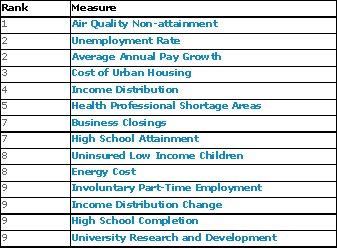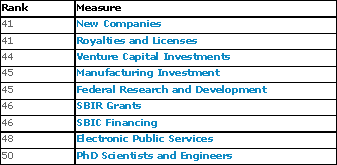
Taxes in Nebraska > Sources of Major State and Local Taxes > Major Policy Trends - The Growth of Economic Development Tax Incentives > Comparison with Other States
COMPARISON WITH OTHER STATES
The tax incentive field is constantly changing. Because of the great variety of incentives and general changes in tax policy that are designed to attract business, it is very difficult to make comparisons or keep an accurate count. This section will compare Nebraska to other states by looking at the most common tax incentives and counting how many states, and how many that are contiguous to Nebraska have a particular tax incentive in some form. It will not attempt to qualify the relative generosity of the incentives. This section will then move beyond tax incentives to focus on business tax climate and look at a few comparisons of tax climate among the states.
Current Incentives
Tax incentives are pervasive, with every state except Wyoming credited with having at least one. Nearly all states now have tax credits for job creation and/or investment and nearly all provide a sales tax exemption, credit, or refund for industrial machinery or equipment. More than 40 provide property tax exemptions or credits on real estate or business equipment, although many of these programs involve tax increment financing.
Site Selection
magazine, in November 2005 reported that 45 states have job creation
or investment tax credits, including Nebraska and all
surrounding
states except Wyoming.
Recently, tax credits have been created or expanded to specifically target
high tech businesses. While seventeen states had research and development
tax credits or exemptions in 1998, Site Selection reported that 42 had
research and development incentives in 2005.
Credits against withholding, like those provided by the Invest Nebraska
Act, and the Nebraska Advantage Act have become more common although
fewer that half the states provide such an incentive today. Nebraska
was one of the first when it enacted the Quality Jobs Act in 1995.
According to Site Selection magazine (November 2005) 40 states allow
some sort of property tax exemption on real property although most are
local option and many exclude the school levy from the exemption. This
list includes Nebraska, so the category includes tax increment financing.
Forty-four states, including Nebraska and all surrounding states except
Wyoming grant a property tax exemption or moratorium on manufacturing
machinery and equipment.
Also according to Site Selection magazine, all states except Wyoming either exempt manufacturing machinery and equipment from the sales tax in whole or in part, or allow credits to be used against the tax. Often, sales tax exemptions or credits are targeted to particular industries, such as manufacturing machinery and equipment. This exemption was enacted in Nebraska by LB 312 (2005, effective Jan. 1, 2006).
According to Patricia Herrera, Vice President of Minitax, in an article entitled "Overview of Discretionary Sales Tax Incentives", State Tax Notes, Oct. 17, 2005, pp. 275 – 303, 21 states, including Colorado, Iowa, and Kansas have a sales tax exemption, credit or refund for business purchases made in an enterprise zone or other designated target area. Fifteen states, including Iowa, Nebraska, and South Dakota have sales tax exemptions or refund programs that are conditioned upon meeting investment and/or employment thresholds.
In addition to programs designed to promote general industrial growth, some programs focus on particular industries. According to Herrera, eight states, including Nebraska have sales and use tax credits, exemptions or refunds available for high tech industries, four for film production and three for tourism attractions.
Although not technically tax incentives, many states, including Nebraska have increased weighting accorded to the receipts factor in apportioning the income of multistate businesses for corporate income tax purposes. After the adoption of the Uniform Division of Income for Tax Purposes Act by the Uniform Law Commissioners, states nearly universally adopted the practice of dividing (or apportioning) the total income of a multistate business between the states with jurisdiction to tax that income using a three-factor formula based one-third on the property in the state as compared to the property of the corporation located in the U.S.; one-third on the payroll in the state as compared to payroll in the U.S.; and one-third on the receipts in the state as compared to receipts in the U.S. At that time, it was felt that these three factors "fairly" portrayed the locations where businesses earned income that should be subject to income tax.
Beginning in the 1980s, many states began increasing the weighting given to the "sales factor". Increasing this factor increases the amount of income apportioned to the state for those industries that are selling products in the state (including retailers) and reducing the amount of income apportioned to the state by those industries producing goods and services in the state through employees and/or property. This shift of tax burden from production businesses to market businesses was designed to encourage investment in production facilities in the state.
Today, according to "State Tax Review" a publication by Commerce Clearing House, dated June 21, 2005, only 16 states mandate an evenly weighted three-factor formula for at least some industries. These states include Colorado, Kansas, and Missouri. The most common formula double-weights the sales factor, with 22 states requiring that apportionment formula for at least some industries. Thirteen states, including Iowa, Nebraska, and Missouri require or permit apportionment using only the sales factor or are transitioning to single factor apportionment. Missouri is included in both the single factor and three factor evenly-weighted list because it allows corporations to choose which of the two formulas is best for them. A number of states are counted more than once because different formulas apply to different industries or because the business has discretion to choose an apportionment formula. Finally, seven states have formulas that weight sales even greater than doubled.
Trends in Accountability
Good Jobs First, a Washington D.C. research organization reported in 2003 that 43 states, 41 cities, and five counties now attach job quality standards to at least one incentive program. This number was up from 37 states in 2000 and only six in 1994. Most of these job quality standards were wage requirements, but a few required health insurance benefits or full-time hours.
Nearly all states require claw-backs if the employment or investment thresholds are never attained or are not maintained for certain a number of years after the businesses received the tax incentives. In Nebraska, "recapture" of past taxes if the company fails to attain or maintain the required number of jobs or investment has long been a requirement for receiving tax incentives.
A few states are beginning to require more disclosure and accountability as a condition for tax incentive benefits. North Carolina and Minnesota are among the leaders in accountability for tax incentives. North Carolina law allows disclosure of company-specific information on tax credits earned and used as well as employment and investment levels. Under LB 312, beginning with new beneficiaries after Jan. 1, 2006 the Department of Revenue will report two-year totals of benefits received on a company specific basis.
Business Climate Comparisons
There are many measures of business climate that may be found with little effort and they reach conflicting conclusions. Many factors are considered by businesses in comparing location proposals and each situation is different. When businesses examine different locations the priority of the factors varies from business to business. For example, low tax burdens and high educational quality are both important for businesses considering relocation, but these two considerations are inversely related. Which is the more important depends on the business considering the relocation. Among the important non-tax considerations are labor availability and education, access to markets and suppliers, job training programs, access to transportation, workers compensation costs, environmental and regulatory concerns, and livability of the community.
Even publications that speak only of tax climate vary a great deal. Peter Fisher, a professor with the University of Iowa's Urban and Regional Planning Program examined five rating publications produced by "think tanks" in the U.S., (1) the "Small Business Survival Index" produced by the Small Business and Entrepreneurship Council; (2) the "State Business Tax climate Index," produced annually by the Tax Foundation; (3) the "Metro Area and State Competitiveness Report" produced annually by the Beacon Hill Institute; (4) the "Fiscal Policy Report Card on America's Governors," produced biennially by the Cato Institute; and (5) the "Economic Freedom Index'" first published by the Pacific Research Institute in 2004. He found that none of the publications were reliable indicators of business growth. Moreover, 34 of the 50 states rank in the top 10 in one or more of the rankings while 42 of the 50 states are in the bottom half of one or more of the rankings. In his opinion, these rankings by "think tanks" reflect nothing more than the political position and bias that is the philosophical drive of the think tank.
Picking one of the think tank rankings as an example, the Tax Foundation's State Business Tax Climate Index for 2005, shows that Nebraska ranks 35th out of 50 states. The ranking examined five main factors with two or more sub factors underlying each main factor.
In looking at the main factors, Nebraska ranked 42nd in "Corporate Income Tax Index" and 28th in the "Individual Income Tax Index". With regard to both indexes, Nebraska suffered because it has an income tax and because each tax has multiple rates. Nine of the top 10 states in this factor were the nine with no income taxes. Because the political position of the Tax Foundation opposes income taxes, especially progressive ones with multiple rate schedules, the Nebraska income tax system means that the state has several strikes against it for the same factor.
The state does fairly well on the "Unemployment Insurance Tax Index" (16th), but does poorly on "Sales Tax Index" (34th) and the "Fiscal Balance Index" (32nd). Nebraska fares poorly with regard to the sales tax index because the law allows local sales taxes, combined rates are relatively high, and the state taxes business inputs, especially machinery and services (services are all assumed to be business inputs in the index). The exemption of manufacturing machinery and equipment by LB 312 (2005) will improve the state's rank on this index. Nebraska fares poorly with regard to the "Fiscal Balance Index" because we have no constitutional restraints on taxation.
Incidentally, tax incentives play no part in the rankings or any of the factors considered by the Tax Foundation.
Looking at a think tank ranking with an entirely different political position yields different results. The CFED (formerly the Corporation for Enterprise Development) gives Nebraska an A in its "Performance Index", a D in its "Business Vitality Index" and a C in its "Development Capacity Index". Strengths of Nebraska according to CFED are:

Weaknesses were:

Forbes Magazine produces a more neutral ranking of the "Best States For Business" (Aug. 16, 2006). This ranking examines all states on six factors, Business costs, including taxes, labor, regulatory environment, economic climate, growth prospects and quality of life. In this ranking, Nebraska is 7th in the nation, trailing only fifth-ranked Colorado regionally. South Dakota is 17th, Kansas 21st, Missouri 22nd, Wyoming 23rd and Iowa 25th. Nebraska did best in business costs, regulatory environment, and quality of life.
In examining only business costs, Nebraska ranked ninth, trailing top-ranked Wyoming, second-ranked South Dakota, and eighth-ranked Iowa. Missouri is 21st, Kansas 28th, and Colorado 31st.
Forbes also publishes a city ranking called the "Best Places for Business" which uses three factors: cost, job growth, and educational attainment. Instead of looking at states as a whole, the ranking examines the 200 largest metropolitan areas. In this ranking, Omaha, Nebraska places 34th best in the nation, and Lincoln 40th.
Other cities in adjacent states included . Des Moines, 11th, Boulder, 26th, Colorado Springs, 35th, St. Louis, 47th, Denver, 50th, Springfield (Mo.), 54th, Cedar Rapids (Ia.), 64th, and Kansas City (Mo.), 68th. This list is limited somewhat by the fact that no cities in either South Dakota or Wyoming were large enough to make the rankings.
The Milken Institute recently updated its annual Cost-of-Doing-Business Index. The index considers five factors: (1) wage costs (50% weighting); tax burden (20% weighting); electricity costs (15% weighting); industrial rent costs (10% weighting); and office rent costs (5% weighting). The following chart shows the regional results with national rankings in parentheses for the overall index and the tax burden index. The tax burden index is merely the total state and local tax receipts as a share of personal income, both as reported by the Census Bureau.
Milken Institute Rankings of the Cost-of-Doing-Business |
|
Cost-of-Doing-Business Index Wyoming (23) Colorado (28) Kansas (33) Missouri (36) Nebraska (38) Iowa (48) South Dakota (50) |
Tax Burden Index Wyoming (3) Nebraska (16) Kansas (26) Iowa (38) Missouri (46) South Dakota (48) Colorado (49) |
Source: State Policy Reports, Federal Funds Information for States, Washington D.C, Vol. 23, Issue 20, October 2005
Using this index, Nebraska fares well, even though the tax burden is above average. Wyoming does not fare well, primarily because of a high tax burden even though we know that much of the Wyoming tax burden is exported to other states through mineral extraction taxes.
The conclusion from all of this conflicting material is that there is no conclusion. Different observers and different businesses look at different things.
| Some activity on the chart above -- such as spikes and troughs -- can be traced to policy decisions made by the Legislature. To view additional information about these changes, click on a bill number below. A chronology of legislative action will open in a new window; the bill you selected will be viewable at the top of the new page. | |
| YEAR | LEGISLATIVE ACTIVITY |
| 1985 | LB 273 |
| 1986 | LB 1124 |
| 1987 | LB 775 |
| 1988 | LB 1234 |
| 1989 | LB 335 |
| 1990 | LB 431 |
| 1992 | LB 1240 |
| 1993 | LB 725 |
| 1995 | LBs 377, 829, 830 |
| 1996 | |
| 1997 | LBs 264, 875 |
| 1998 | LB 939 |
| 1999 | LBs 87A, 539, 605 |
| 2000 | LBs 936, 968 |
| 2001 | LBs 536, 620 |
| 2003 | LB 608 |
| 2004 | LBs 479, 1065 |
| 2005 | LBs 90, 312 |
Additional Information: